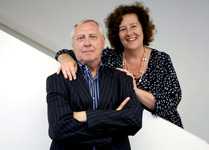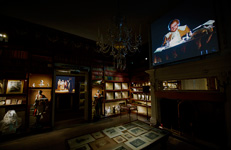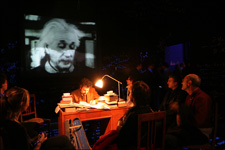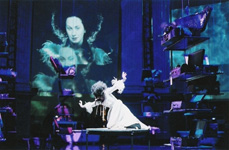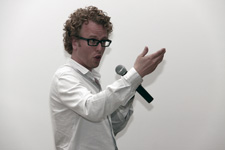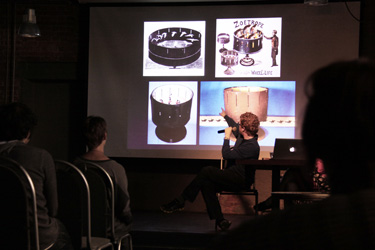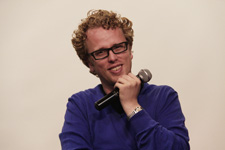Media project “Immersions into the Future”
October 31 — November 2, 2013
Crocus Expo
as a part of the Open Innovations Forum
Organizers: MEC «Manege», centre for culture and art « MediaArtLab», Museum of screen culture «Manege/MediaArtLab»
Curator: Olga Shishko (art critic, curator, MediaArtLab founder and director, art director of the MIFF Media Forum of the , director of the Museum of screen culture Manege/MediaArtLab)
Producer: Elena Rumyantseva (program director of the Museum of Screen Culture Manege/MediaArtLab and the MIFF Media Forum)
Participants: Where the Dogs Run (Russia), Dmitry Kavarga (Russia), Sergey Katran (Russia), Alexandra Dementyeva (Russia-Belgium), Boris Debackere (the Netherlands-Belgium), Elena Gubanova and Ivan Govorkov (Russia), Yury Ankarani (Italy), Vladimir Potapov (Russia), Dmitry Bulatov and Alexey Chebykin (Russia), ABC (Russia).
Architect: Dina Karaman
Coordinator: Olga Pogasova
The Future is here
Stunned victims of new technology constantly muttered common clichés about the impracticality of artists and their tendency to fantasize. However, in the last century, there was a general recognition that, in the words of Wyndham Lewis, "the artist is always busy writing a detailed history of the future, because only he is aware of the nature of this”.
Marshall McLuhan
The space of the cultural program of the Forum and Exhibition is a complex hybrid organism, consisting of expositions and visitors, the interaction of which (in fact, merging of humans and technologies) is the main instrument of the realisation of the artists’ ideas. The combination of precise (science), imagined (art) and human, who initiates the art process is the realisation of synergy, expressed in the language of art.
The art of multimedia plays the role of an experimental laboratory, not only for new technologies, but also for the study of new relations of communication, created or supported by these technologies. The artists not only use them, but study them. In this sense new multimedia art could be viewed as the follower of the avant-garde movement.
Overcoming public fear before the world of new technologies, artists ask a question about the Utopia of the Electronic Paradise. New technologies of the emerging visual sphere are a challenge for an artist: how these new means can be included into the process of artistic expression, how their content is defined, their virtual language is developed to be their main means of expression?
Who can dare to state whether reality today tends to become a fiction or fiction becomes a reality? Such uncertainty creates a fear to get lost in the worlds of the manipulated and manipulating images.
For more than a century art tries to critically examine the reality. It tries to be a means of knowing the world, with the help of which reality can be tested, things unseen by an ordinary eye can be seen and even life can be transformed and modelled freely. Artists play with the ideals of mass culture and consumption society, put them under question, laugh at them openly or use many other strategies.
At the same time time and the development of the technical equipment as well as of the visual language in general alter the perception of the viewer. The modern viewer is ready to interact with a piece of art as with reality, to be included into the environment, constructed by an artist, become a co-author and a participant.
The talk of art dissolving in the mass culture continues for many years. What is going on? Can we give any prognosis and talk of opposition Present/Future? What is more important for an artist: reflection or ability to predict tomorrow?
Cultural program: special events
Screenings, workshops, presentations, excursions
As a part of the cultural program of the Forum a series of educational events will take place. Presentations of artists from different countries will be devoted to the integration of new technologies, synthesis of art and science. The participants of the program will talk of the creation of art objects from innovative materials, new mechanisms of performances and innovative approach to communication with the audience.
Events:
— Daily excursions around the exhibition for adults and kids by the curator Olga Shishko
Olga Shishko - art expert, curator. Her research activities focus on different aspects of contemporary media art (Art on the Net, Video, Cyberculture, etc.). Curator of exhibitions: TRANSITLAND: Video art from Central and Eastern Europe after the fall of the Berlin Wall 1989-2009 (2010), Gary Hill's videoart exhibition Viewer (2010,), Expanded Cinema — 3 (2011), Immersions: Towards The Haptic Cinema (2012), "Expanded Cinema — 3. Mocumentary: Reality Is Not Enough" (2013). Author and redactor of contemporary media art issues published in Russia.
— Presentation of the project “The Golden Age of Russian Avant-Garde” by Peter Greenaway and Saskia Boddeke. Hosted by Olga Shishko, Museum of Screen Culture, director, and Annette Mosk, producer of the project (Holland).
Avant-gardist Peter Greenaway is famous for his epoch-making films. His narrative was concentrated around the images of classical painting and architecture, including history of art concepts and cinema theory. Japanese calligraphy and multimedia technologies were used for the realisation of a multi-dimensional director’s idea. Then all this morphed into a whole new way of creating artworks. He rejected cinematographic narrative and travels around the world, creating multimedia installations. In April, 2014, Moscow Manege Museum will host the premiere of a new work of the director, co-authored by him with a famous theatre director Saskia Boddeke specially for the Museum of Screen Culture Manege/MediaArtLab. More than 400 pieces of Russian avant-garde art will be used for the realisation of the project. With the help of the latest screen technologies a huge multi-screen installation using the screens of the back projection and spatial decorations.
— Screening of video and media works of the festival Ars Electronica (Austria)
Ars Electronica is perhaps one of the most influential media art festivals in Europe. It is in fact the very best multimedia art festival in the Old World. Every year it shows the trends and discovers the new names in 6 directions: computer animation and cinema, digital music and sound art, interactive art, hybrid arts, art of digital communities, synergy of art and science. The prize of the festival is for an artist a recognition on the highest level.
-— Lecture by Boris Debackere Additional Dreams
Many forms of art can be considered as additions to reality. What are the problems this amended reality position to us - these technologies, which expand physical reality superimposing interactive computer generated content on it, when they are used as medium for art? Artist should critically re-examine their application. The key point in the creation of an art work is: what is it supposed to say? and: what is the audience supposed to feel? Cinema is an interesting example for this, stimulating our imagination for over than 100 years and followed by countless media which try to impose a similar experience on their audience. In order to appear, a cinematographic illusion addresses imagination. Film functions as a trigger of a mental process, which creates an illusion of reality in the consciousness. The present-day rapid progress in the field of information technology inevitably creates new ways of possible experience of moving images, changing relations between the creator, his tools and the audience.
-— Lecture by Alexandra Dementyeva Interactive Art
Presentation by a Russian-Belgian media artist and theorist of new media, professor of ZKM Centre for Arts and Media Technologies, Karlsruhe, Germany, will be devoted to the art of new technologies in the field of design and entertainment industry
— Presentation of an anthology “Evolution of Haute Couture: Art and Science in the era of post-biology”
 The presentation by the curator of the NCCA Dmitry Bulatov will be devoted to introducing the public to the second volume of an international anthology “Evolution of Haute Couture: Art and Science in the Age of Post-biology”. This book is dedicated to the analysis of the evolutionary potential inherent in the main technological trends of the 21 st century such as robotics, IT, bio-medicine and nano technology. This edition embraces a broad spectrum of artistic, aesthetic and philosophical problems of the post-biological age - conditions when technology is directly linked to the target state of the organism. The book was created by 30 famous representatives of contemporary art, philosophy, social science and applied sciences, including Andy Pickering, one of the most important specialist in the history of science, UK, Boris Groys, leading expert in Russian Art of the 20th century, USA, Stelarc (pioneer of technobiological avant-garde, Australia, Erkki Huhtamo, one of the key figures in the archaeology of new media, USA, Yens Hauser, a famous theorist of bio-art, France, Pierre-Luigi Capucci, expert in science art, Italy, Paul Brown, a pioneer in electronic art, UK.
The presentation by the curator of the NCCA Dmitry Bulatov will be devoted to introducing the public to the second volume of an international anthology “Evolution of Haute Couture: Art and Science in the Age of Post-biology”. This book is dedicated to the analysis of the evolutionary potential inherent in the main technological trends of the 21 st century such as robotics, IT, bio-medicine and nano technology. This edition embraces a broad spectrum of artistic, aesthetic and philosophical problems of the post-biological age - conditions when technology is directly linked to the target state of the organism. The book was created by 30 famous representatives of contemporary art, philosophy, social science and applied sciences, including Andy Pickering, one of the most important specialist in the history of science, UK, Boris Groys, leading expert in Russian Art of the 20th century, USA, Stelarc (pioneer of technobiological avant-garde, Australia, Erkki Huhtamo, one of the key figures in the archaeology of new media, USA, Yens Hauser, a famous theorist of bio-art, France, Pierre-Luigi Capucci, expert in science art, Italy, Paul Brown, a pioneer in electronic art, UK.



